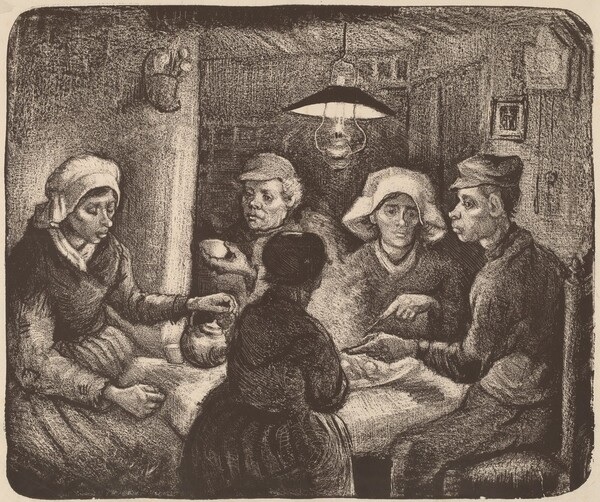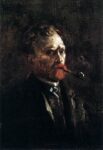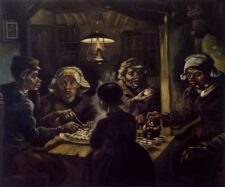
Vincent Van Gogh
Dutch, 1853–1890
The Potato Eaters, 1885
lithograph in dark brown
10 3/8 x 12 7/16 in.
National Gallery of Art, Washington, DC, Rosenwald Collection

Van Gogh - Self-Portrait with Pipe, 1886
“Just wanted to tell you that I’m hard at work on the potato eaters. I’ve started it again on a new canvas and painted new studies of the heads; changed the hands, in particular, a great deal. Above all, I’m doing my best to put life into it.”
- Letter to Theo, 28 April 1885

Van Gogh - The Potato Eaters, 1885, Oil on canvas, Van Gogh Museum
COMMENTS
THE PAINTING
The idea first touched paper sometime in March [1885], before his father’s death, with a loose, blowsy sketch of peasants seated around a table. At the time, Vincent was spending many evenings at Gordina de Groot’s tumbledown cottage on the road to Gerwen, and he later claimed as his inspiration the sight of Gordina and her family at the dinner table. But the image that took shape in April, in a torrent of drawings and painted studies, tapped much deeper and more tangled roots.
No doubt, Vincent saw the tableau of the De Groots at their table through a kaleidoscope of other images. From the monumental laborers of Millet to the idealized rustics of Breton to the bathetic simplefolk of Israëls, he had memorized the era’s narcissistic fascination with its own humble past. He had also absorbed scores of images of families at table, sharing both food and prayer. Since the seventeenth century, when English and Dutch Pietists put mealtime “grace” at the center of domestic religious life, artists from Jan Steen to Hubert Herkomer had celebrated this daily ritual in paintings and prints. Vincent ardently admired Charles de Groux’s “The Benediction”, a solemn, “Last Supper”-like panorama of a peasant family giving thanks; and he hung Gustave Brion’s version of the same scene in his room in Amsterdam. Masters of nostalgia like Israëls had revived the subject, with and without prayer, for the new, backward-looking bourgeois class.
In The Hague, in 1882, Vincent had seen one of the many variations on Israëls’s hugely successful “The Frugal Meal”, and proclaimed Israëls “the equal of Millet.” Younger artists, inspired by Israëls, had taken up the subject, too, until heartwarming dinner table scenes had become ubiquitous. To find examples, Vincent had to look no further than his portfolios of magazine illustrations, or the studio of his friend Anthon van Rappard, whose paintings of institutional “families” gathered around tables had impressed him on his visits to Utrecht.
In the storm of argument to come, Vincent would claim all theses, and more, as godfathers to his new work. But for a man who could still recite his father’s dinnertime blessing, no mere image could match the resonance of the empty chair at the head of the parsonage table. When Vincent looked at the strange, extended De Groot family gathered in the yellow lamplight, he could not help but see the oil lamp that lighted every dinner of his childhood, and the table at which he was no longer welcome.
In the first week after the funeral, Vincent worked furiously to bring forth the image in his head. He made drawing after drawing of figures around a table, experimenting with their placement, their posture, the way they perched on their chairs. He returned again and again to the house on the Gerwen road to check his vision against Gordina’s ever-willing and seemingly oblivious clan. He sketched the cottage’s gloomy interior, with its beamed ceiling, its broken glass transom, and its yawning, soot-stained hearth. He peered into the darkness to make detailed studies of everything from the clock on the wall to the kettle on the fire to the knobs on the chairs…
Like Millet, Vincent wanted his depictions to celebrate not just the peasants’ oneness with nature (their “harmony’ with the countryside) but also their stolid resignation in the face of crushing labor – the same noble resignation he had admired in the old cab horses of London, Paris, and Brussels, hauling dung or ashes through the streets “patiently and meekly … awaiting their last hour.” Throughout the winter, in his endless portrait heads, Vincent had worked to endow his models’ faces and hands with the immortality of toil. Now he brought all those lessons to bear on a final flurry of preparatory studies, both drawn and painted, for the figures around the table.
To give these humble eats the solemnity and significance they deserved, he set them in their natural habitat: darkness. He had long been fascinated with the gloomy cottages – “caves,” he called them – in which families like the De Groots lived. But not even his darkest palette could penetrate the almost total obscurity of these thatch-roofed hovels. In the past, he had solved the problem by placing his figures against the bright light of a window, or by carving them out of the darkness in a woodcutter’s economy of highlights. Even before he became an artist, his imagination had been seized by the drama of objects emerging from shadows, or silhouetted against coronas of backlight. To him, “effects” like these revealed an immortal dimension, and as early as Etten he had begun experimenting with them. “I want something broad and audacious, with silhouette and relief in it,” he said of his group drawings in The Hague. In his images of weavers, he enlisted both shadow and silhouette to confer sublimity on his simple subjects, as well as to conceal his awkward drawing.
For his new tableau of peasants around a table, he sketched the scene both ways: at a midday meal in front of a window, and at supper in the chiaroscuro of lamplight. He quickly decided on the latter, darker vision: he would portray his diners in the blackness of their night meal, revealed only by the yellow light of the oil lamp over the table. He had already practiced this Strygian palette in several paintings in March, creating elaborate mixes of hues to achieve a narrow range of brown-green, green-blue, and blue-black – what he called “the color of dark soft soap…”
Although he trudged many nights to the De Groot house to refresh his imagination in the lamplight, he relied increasingly on his portrait studies of the winter for the faces and hands around the table. To emphasize the claustrophobia of the little cottage, he lowered the beamed ceiling, crammed more of the room into the picture frame, and crowded it with more and more domestic details: a mirror, a clog filled with utensils, a devotional print of the Crucifixion.
Finally, responding to an unknown mandate, he radically reimagined the characters in his narrative. Instead of four hungry peasants hovering over their meager meal, as remote from each other as livestock at a trough, Vincent painted a family. Instead of Gordina’s anarchic in-law household, with its course manners and strange relationships, he created a scene as familiar as a memory: at a table set with a tablecloth, a marital couple politely share a dish of potatoes, a matriarch pours coffee for all, and a child waits obediently to be served.
Lastly, Vincent added a new figure, a fifth person, seated in the back, a newcomer at this family ritual. He is an odd-looking man with an open, plaintive face and a hint of red hair.
THE LITHOGRAPH
By early May, he had moved everything into the cluttered Kerkstraat studio, a few blocks from the parsonage. On the easel sat a third and final attempt to paint "The Potato Eaters", wet with endless reworkings. In the furor of his battle with his own family, he had begun an even bigger canvas, almost three by four feet, trying again to capture the phantom of familyhood in his head. He had painted and drawn and imagined the figures at the table so often that he didn't need to refer to his sketches or studies any longer. "I paint it by heart," he said.
Vincent had been obsessed with the image throughout his slow, painful expulsion from the parsonage. After he finished the second attempt in mid-April, he immediately announced his intention to make a lithograph of it. Without waiting for Theo's opinion of the image or the venture, he went to Eindhoven and contracted to print 50 copies. As his own home life fell apart, he reworked the image again on the stone and laid ambitious plans for an entire series of lithographs based on the same theme: "les paysans chez eux" – peasants at home. He sent Theo repeated sketches of the image, urging him to show it to friends and fellow dealers. He wondered if the editor of "Le Chat Noir", a chic Parisian art magazine, "might want a rough drawing of those potato eaters," and offered to make one in any size,
Ignoring his brother's repeated discouragement, he seized triumphantly on the report that one of Theo's colleagues, a minor dealer named Arsène Portier, had "seen something" in his earlier work. He immediately wrote Portier a long latter "giving him arguments for his own instinctive feelings" and exhorting him to stand fast in his opinion. Portier's polite compliment (he said Vincent's work had "personaliity) whipped Vincent into a froth of anticipation in the last weeks of April. When the lithographs came back from the printer, he sent copies to Theo, Rappard, Portier, even his old Goupil colleague Elbert Jan van Wisselingh – giving them out like cigars at a birth, celebrating not just the image, which continued to change with every iteration, but the new mission that it represented. "It is a subject that I have felt," he said. "There is a certain 'life' in it."
- Steven Naifeh and Gregory White Smith, Van Gogh: The Life, New York: Random House, 2011, 424-428, 436-437
SBMA CURATORIAL LABELS
This lithograph was intended by Vincent to be one of a series that he planned, in his words, “of subjects from peasant life, in short—the peasants at home.” By 1885, Van Gogh had spent nearly four years diligently attempting to master the representation of the human figure. The painted version of The Potato Eaters was supposed to announce his arrival as a fully mature artist, committed to the truthful and respectful depiction of ‘real’ peasants, just as they were and not idealized. To Van Gogh, the medium of lithography held the promise of providing an affordable form of art “from the people and for the people.” Vincent made many drawn and painted studies of the de Groots, a farm family in Nuenen. They were likely the models for the five figures engaged in the everyday activity of consuming their humble repast.
Though secular in nature, the strong chiaroscuro created by the single source of illumination at the composition’s center recalls that of Rembrandt’s religious prints, which Van Gogh knew well. This illumination was likely intended by Van Gogh to lend a dignifying spirituality to these otherwise unabashedly ugly workers of the land.
- Through Vincent's Eyes, 2022
